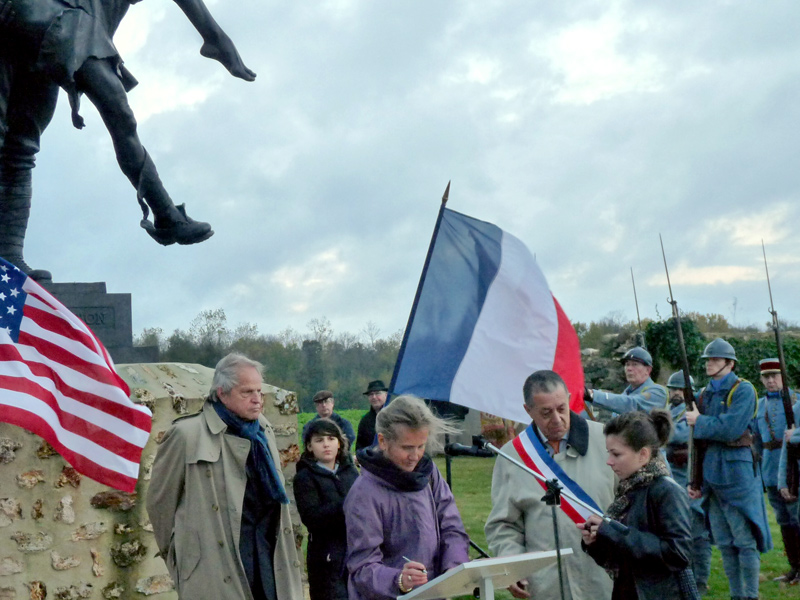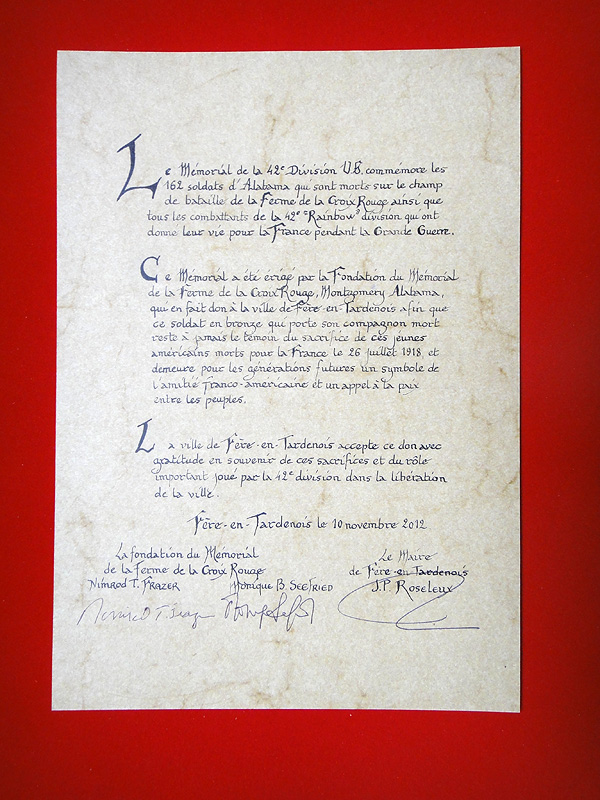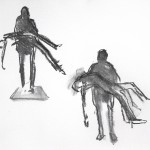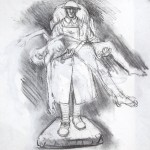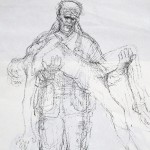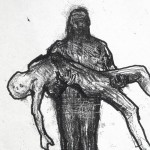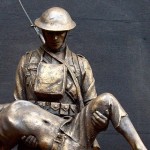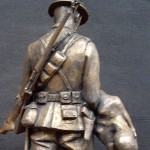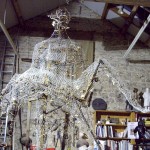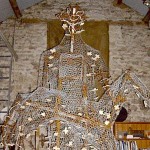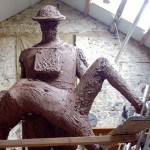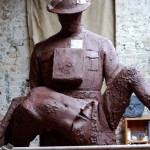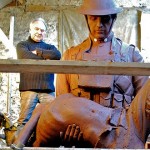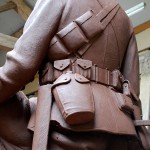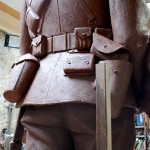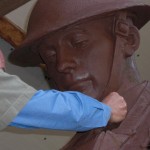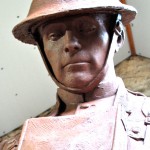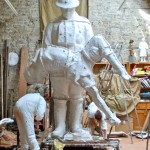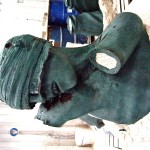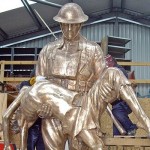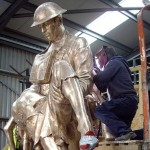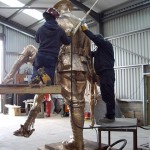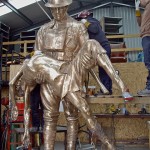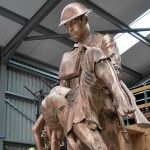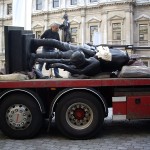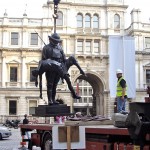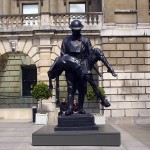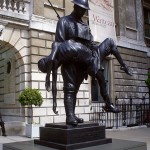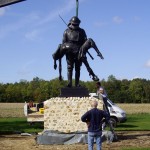The 42nd Rainbow Division Memorial
Sculptor – James Butler, MBE R.A.
The Inspiration
“I have made a number of statues with a military theme. I was in the army myself and have a great admiration and sympathy for the lot of the common soldier and how sometimes the most ordinary man will rise to the heights of great bravery and concern for his fellow soldier. In the 42nd Rainbow Division memorial, my original idea was to portray the powerful bond between men on active service with a soldier carrying his dead comrade. However after working on the sculpture for some time the piece began to have a strong spiritual meaning for me. The dead soldier is limp as if his body had just been lifted from the battlefield. The figure holding the dead man began to have the presence of the Angel of Mercy. He is perfect – there are no battle scars on him and he is untouched by the grim conflict. I am not a religious man, but working on this sculpture I felt a strong spiritual guidance.” – James Butler
The Method
“I first made a maquette some two feet high. This is where I worked out the relationship between the two figures – the way they would relate to each other and the general balance and mass of the composition. The Croix Rouge Memorial Foundation approved my model or maquette. I then had to begin construction of the full sized version. With some assistance, an armature or steel frame was constructed some five times the size of the maquette. This had to be strong and able to carry the weight of the clay, which is the medium I use to model the form. Clay is a wonderfully expressive material and faithfully records the movement of the sculptors hands. When the clay sculpture is finished the translation of the form into bronze begins.” – James Butler
The bronze was cast using the lost wax method of casting.
A rubber mould is first made by painting or dribbling liquid rubber onto the surface of the clay. When this is set a jacket is made by laying fiberglass and resin onto the rubber in sections that can be handled by the molder, the resin sections are taken off and the rubber mould is cut and laid into the resin jacket. This process is repeated all over the clay statue – in this case there were 35 sections.
Molten wax is then painted onto the inside of the rubber mould and when cool the rubber is peeled off and the wax surface is checked by the sculptor for an exact reproduction of his clay. A mould is made around the wax section. The mould into which the bronze is poured is made of investing plaster or ceramic shell which is a mix of investing plaster and pre fired clay which gives a very fine and accurate surface taking up all the fine detail of the modeling. All bronzes are made hollow because of the contraction of molten metal when it cools. The inside of the wax casting is filled with an investing plaster. Nails are driven through the mould into the plaster which now becomes a solid core. The nails are to prevent the core dropping when the wax is melted out. A system of wax rods are added to act as canals to allow the molten bronze to run around the mould and small “risers” are added to various high points to prevent air being trapped by the molten bronze as it flows around the mould. The whole is placed into a kiln and brought to a very high temperature. The wax, which is now molten runs out of the mould and molten bronze is poured into the mould, taking up the exact detail of the wax. When cooled the mould is broken to reveal the bronze sculpture. When carefully cleaned and chased the bronze is a rather bright shiny color – like a new penny but rather blotchy in appearance.
The bronze sections are welded together. The resulting seams are chased and the textures matched by highly skilled craftsmen.
Finally the surface is patinated in order to give the bronze a uniform color. It is done with a solution of various salts and acids to arrive at a range of colors from green, blue and different shades of brown to black. The bronze is given a uniform color, according to the wishes of the artist.
It is in the nature of bronze, which is an alloy of copper and tin to steadily go darker in color as the material is exposed to the oxidizing process which occurs when bronze is in the open air. The Rainbow Division memorial is now patinated, or colored black. This will remain its permanent color because the color is not an applied paint, but a changing of the color of the bronze itself.
The Soldier
The Soldier wears the three stripes of a Sergeant’s rank on the right sleeve. There was one per platoon and he was the senior enlisted person in the platoon. The gas mask carried on the Soldier’s chest is opened with the flap to the outside for easy access. The rifle (.30 Cal. Bolt Action US Springfield 1903 model with 5 round clip) is slung for marching with bayonet attached. The bayonet scabbard was web covered with a double catch at top for attachment to the ammo belt. Douglas MacArthur, Rainbow Chief of Staff at the time said, “The battle of Croix Rouge Farm was one of the few times in which the bayonet was successfully used.” The helmet is US 1917 model with leather chin straps. Tunic is standard US model 1917 with untapered shoulder straps. Shoes with brass hobbed nail heels and soles and brass shoe lace eyelets were issued in France. Leggings were made of wool strips and adopted from the British standard. A Bandoleer of light cotton construction is slung over right shoulder with sixty round capacity, six pockets each containing two five round clips of ball ammunition. Two hundred and fifty rounds was the standard basic load for a rifleman going into battle. The cartridge belt was 1910 woven web (dismounted model) with 10 rifle ammo pockets each holding two five round clips of .30-06 ammunition. A harness crossing both shoulders attached to the front and back of the cartridge belt for support. The canteen and first aid kit in canvas containers were attached by eyelets to the back of the cartridge belt. The pistol was used by any soldier who wanted one by the time of the battle at Croix Rouge Farm after having been issued only to squad leaders, platoon sergeants and officers in early operations. The pistol was model 1911 .45 cal. Automatic carried in a leather model 1916 auto holster.
The Foundry
The bronze casting was done by Black Isle Foundry located in Nairn, near Inverness. Moulds of the clay model were made in the artist’s studio in Warwickshire, and sent to Scotland. Metal founder Farquhar Laing and his highly skilled team of craftsmen, turned the work of James Butler into this splendid bronze statue. Black Isle Foundry delivered the Rainbow Division Memorial statue to the Royal Academy in London for the 2011 Summer Exhibition and installed it on its permanent site, at the Croix Rouge Farm in France.
Summer Exhibition
Royal Academy of Art
London, UK
From June 7 until August 15, 2011
The Memorial Statue of the Rainbow Division was exhibited in the Annenberg Courtyard as part of the annual Summer Exhibition at the Royal Academy of Art.
Inauguration
The memorial was inaugurated at the Croix Rouge Farm on November 12, 2011.
Transfer of Deed
Ownership of the memorial was transferred to the city of Fère-en-Tardenois on November 10, 2012.
Ownership of the 42nd Rainbow Division Memorial and the hallowed ground it stands upon were officially transferred by the Croix Rouge Farm Memorial Foundation to the city of Fère-en-Tardenois on November 10, 2012.
The deed reads:
The Memorial of the 42nd Division US commemorates the 162 soldiers from Alabama and their Iowa comrades who died on the battle field of the Croix Rouge Farm as well as all the soldiers of the Rainbow Division who gave their life for France during the Great War.
This Memorial was erected by the Croix Rouge Farm Memorial Foundation, Montgomery, Alabama and is now being donated to the city of Fère-en-Tardenois so that this bronze soldier who carries the body of his dead comrade remains forever the witness of the sacrifice made by young Americans on July 26, 1918, that it remains for future generations a symbol of French-American friendship and a call for peace among nations.
The city of Fère-en-Tardenois accepts this gift with gratitude in memory of those sacrifices and of the important role played by the 42nd Division in liberating the city.
Fère-en-Tardenois, November 10, 2012
Nimrod T. Frazer, Monique B. Seefried, Croix Rouge Farm Memorial Foundation
Jean-Paul Roseleux, Mayor of Fère-en-Tardenois


